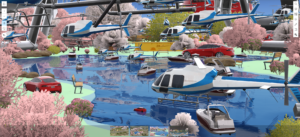Week 6
notes para chapter 7:
- Page 248 number 7 chose the layer USA States Generalized Boundaries
- Page 248 number 11 chose population density instead of pop. per sq. mi. since that was not an available field
- Same for the text as well
https://owugis.maps.arcgis.com/home/webscene/viewer.html?webscene=29ad4c671bc64dc599a71ade1b9994e6
- Designing the 3d objects and watching them sprout up from 2d ones was very satisfying
- I was blown away at the extensive 3d shapefiles that i was able to choose from, really allows for decent amounts of freedom and customization
https://owugis.maps.arcgis.com/home/webscene/viewer.html?webscene=0d46cf98aa2e4424ab1f58e5728916e4
Silly helicopter version
https://owugis.maps.arcgis.com/home/webscene/viewer.html?webscene=8871e440bc054329aff17731fc5ca08a
- Added more silly large helicopters and cars that definitely do not have impervious surfaces left in the park to park at haha
- Page 263 number 6 the analyze toolbar is the scene tool button
- The slice tool option is very interesting, wonder what uses it could have besides like for aesthetic purposes of things clipping through other objects
it seems they havent cleaned up the public layer in a while

a biological application that could be used by 3d renditions of 2d map layers, especially by adding 3d objects into the layer is through making a visual map explanation of an experimental methods approach. this immediately reminds me of the chimney swift project that was proposed in 2018, a chimney shape file could have been used to put the idealized locations of said chimneys to give a very detailed explanation of where exactly they were to be constructed. this of course could be done with endless other project ideas, one that came to mind being placing 3d net shapes at locations where there would be the best chances to mist net and potentially band a song bird species of interest.